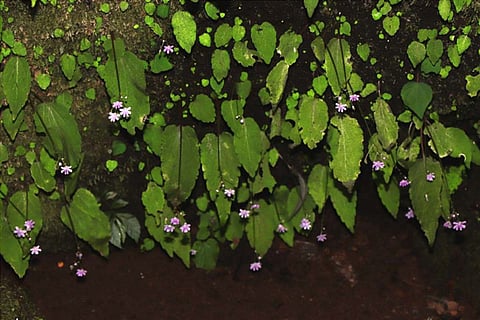

Botanists from Kerala’s Calicut University have discovered three new plant species from Idukki district. All of them have been categorised as endangered according to the International Union for Conservation of Nature’s (IUCN) red list criteria. IUCN’s red list is globally the most comprehensive list mapping the endangered and conservation status of world’s biodiversity.
The plants discovered in Idukki are Eriocaulon vamanae, Impatiens nidholapathra and Impatiens grandispora. While the first is a kind of pipewort, the latter two belong to the Balsam plant family, which flower annually or perennially. While Eriocaulon vamanae and Impatiens grandispora are listed as critically endangered, Impatiens nidholapathra, is categorised as endangered.
Impatiens grandispora
The discoveries were made by a team of botanists including research scholars Vishnu Mohan, Divya K Venugopal, Dani Francis and Professor Santhosh Nampy of the Calicut University. “The team was working as part of the research project funded by Kerala State Council for Science, Technology and Environment, to study the flora of Idukki district,” Professor Santhosh Nampy told TNM.
Eriocaulon vamanae, which was discovered from the Meesapulimala Hills of Idukki, is estimated to occur over less than 100 square kilometres of the area. However, 95 individuals of this species were found over less than 10 square kilometres of the area. “Since the place is a tourist destination, it is vulnerable to destruction. It is assigned as critically endangered,” the researchers wrote in the paper published about the new species in the Edinburgh Journal of Botany. The plant, which was found along the wet meadows around the mountain spring, got its name because of its small size - ‘vamanae’ means ‘dwarf’ in Sanskrit.
Eriocaulon vamanae
The two other plants, Impatiens nidholapathra and Impatiens grandispora, belonging to the Balsam family, were also found in hills of Western Ghats in Idukki district. Both were found on moist rocks. While Impatiens nidholapathra has violet or purple flowers, Impatiens grandispora has white flowers.
“Impatiens nidholapathra was found in three small populations from the Mankulam and Anakulam forests with no more than 30 individuals. The area of occupancy of each population is reduced to 3 metre square. Because of tourism and other anthropogenic activities, the population may become extinct. The conservation status of the species is assessed as an endangered,” says the paper.
Impatiens grandispora quite sensitive to rain, the researchers found. “They start to flower only after receiving ample rain. But any rain during their period of flowering causes the plants to decline, eventually destroying the entire population. This sudden appearance and vanishing caused the tribal people to call them “Wonder Plant”,” the paper says. While there is no perceived threat to this plant’s habitat, it is still categorised as critically endangered because of its small population (25-30 subpopulations) and limited area of occurrence (five square metres).
Watch: